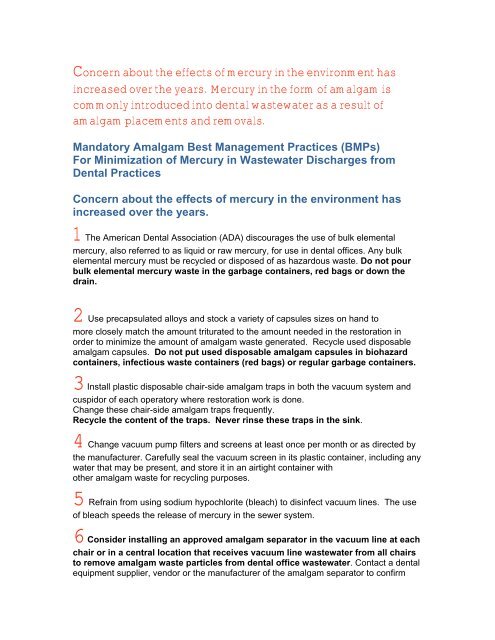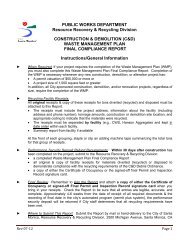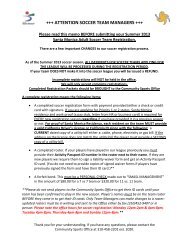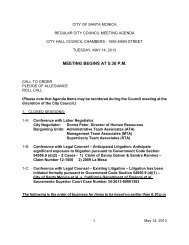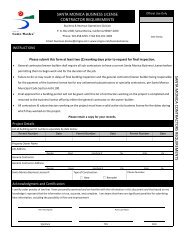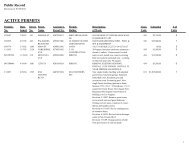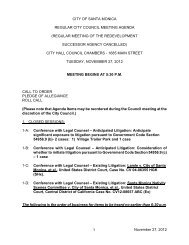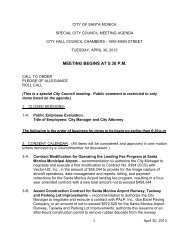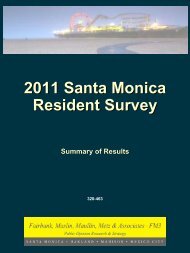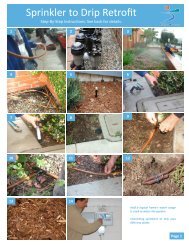Mandatory Amalgam Best Management Practices (BMPs)
Mandatory Amalgam Best Management Practices (BMPs)
Mandatory Amalgam Best Management Practices (BMPs)
Create successful ePaper yourself
Turn your PDF publications into a flip-book with our unique Google optimized e-Paper software.
Concern about the effects of mercury in the environment has<br />
increased over the years. Mercury in the form of amalgam is<br />
commonly introduced into dental wastewater as a result of<br />
amalgam placements and removals.<br />
<strong>Mandatory</strong> <strong>Amalgam</strong> <strong>Best</strong> <strong>Management</strong> <strong>Practices</strong> (<strong>BMPs</strong>)<br />
For Minimization of Mercury in Wastewater Discharges from<br />
Dental <strong>Practices</strong><br />
Concern about the effects of mercury in the environment has<br />
increased over the years.<br />
1 The American Dental Association (ADA) discourages the use of bulk elemental<br />
mercury, also referred to as liquid or raw mercury, for use in dental offices. Any bulk<br />
elemental mercury must be recycled or disposed of as hazardous waste. Do not pour<br />
bulk elemental mercury waste in the garbage containers, red bags or down the<br />
drain.<br />
2 Use precapsulated alloys and stock a variety of capsules sizes on hand to<br />
more closely match the amount triturated to the amount needed in the restoration in<br />
order to minimize the amount of amalgam waste generated. Recycle used disposable<br />
amalgam capsules. Do not put used disposable amalgam capsules in biohazard<br />
containers, infectious waste containers (red bags) or regular garbage containers.<br />
3 Install plastic disposable chair-side amalgam traps in both the vacuum system and<br />
cuspidor of each operatory where restoration work is done.<br />
Change these chair-side amalgam traps frequently.<br />
Recycle the content of the traps. Never rinse these traps in the sink.<br />
4 Change vacuum pump filters and screens at least once per month or as directed by<br />
the manufacturer. Carefully seal the vacuum screen in its plastic container, including any<br />
water that may be present, and store it in an airtight container with<br />
other amalgam waste for recycling purposes.<br />
5 Refrain from using sodium hypochlorite (bleach) to disinfect vacuum lines. The use<br />
of bleach speeds the release of mercury in the sewer system.<br />
6 Consider installing an approved amalgam separator in the vacuum line at each<br />
chair or in a central location that receives vacuum line wastewater from all chairs<br />
to remove amalgam waste particles from dental office wastewater. Contact a dental<br />
equipment supplier, vendor or the manufacturer of the amalgam separator to confirm
that the amalgam separator you have selected from the approved list is compatible with<br />
your system and appropriate for your office. Make arrangement for proper and regular<br />
monitoring and maintenance of the unit.<br />
7 Contact an amalgam waste recycler about any special requirements that may exist<br />
for collecting, storing and transporting amalgam waste. It is important to select a<br />
reputable amalgam recycler that complies with applicable federal and state laws and<br />
provides adequate indemnification for its acts and omissions. A directory of<br />
<strong>Amalgam</strong> Recyclers has been compiled from information supplied by companies listed in<br />
website and other public information sources at the American Dental Association<br />
(ADA) website: www.ada.org.<br />
<strong>Amalgam</strong> waste includes:<br />
• Non-contact amalgam (scrap): excess mix leftover at the end of a dental procedure.<br />
Many recyclers will buy this clean scrap.<br />
• Contact amalgam: amalgam that has been in contact with the patient<br />
(E.g. extracted teeth containing amalgam)<br />
• <strong>Amalgam</strong> sludge: amalgam captured by<br />
chair-side traps, vacuum pump filters, screens,<br />
and other devices.<br />
• Used amalgam capsules<br />
• Leaking or unusable amalgam capsules<br />
8 Store amalgam waste in a covered plastic container dated and labeled “<strong>Amalgam</strong> for<br />
Recycling” or as directed by your recycler. Consider keeping different types (e.g.,<br />
contact and non-contact) of amalgam wastes in separate containers as instructed by<br />
your recycler. Do not use disinfectant solutions with oxidizers, such as bleach, to<br />
disinfect the amalgam. Do not add water or waste fixer to the<br />
waste containers.<br />
9 Obtain receipts or other certified documentation such as hauling manifests from your<br />
recycler or hazardous waste hauler for disposal of all amalgam waste.<br />
Keep these receipts on file for at least three years, and make them available to<br />
authorized City inspectors upon request. Maintain a written or computerized log of<br />
amalgam waste that you generate and you dispose off.<br />
10 Store your waste fixer solution in a properly labeled container and dispose of<br />
through a licensed hazardous waste hauler/ recycler. Waste fixer solution may be<br />
treated on- site using a Silver Recovery Unit.<br />
11 Train staff in the proper handling, manage<br />
ment, and disposal of mercury-containing<br />
solutions. Maintain a training log.<br />
For more information, contact<br />
Water Resources Protection Programs:


